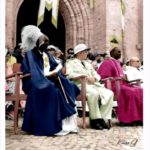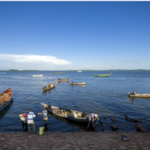The Ryangombe Cult And His Myth
Cult of the dead was not restricted to these spirits called bazimu. At a different level we find the Ryangombe cult in Central Rwanda, and the Nyabingi cult in the peripheral areas.
In Central Rwanda about thirty spirits were considered to be especially powerful. These were called Imandwa or heroes, whose Mwami was Ryangombe. They were considered to be able to control the malevolent activities of the bazimu. The cult rendered to them was very widespread. To come under the protection of Ryangombe and his Imandwa, a person had to be initiated in a trancelike initiationceremony. Those who were initiated could count not only on a greater protection while living but also on a more pleasant after-life than that attained by the normal bazimu. The initiated were supposed to live, after death, on the slopes of the Karisimbi, a volcano in northern Rwanda, spending their time pleasantly drinking, gambling and smoking.
The cult had no other rite than the initiation ceremony and there were no regular officials. It was up to the diviner to determine whether a person, male or female, should be initiated. For the ceremony itself it was required that someone should act the part of Ryangombe and the person to be initiated needed a male and female sponsor.
All these persons were appointed by the diviner, who did not assist at the ceremony himself. The ceremony took place within the context of the lineage in that only initiated lineage members were allowed to be present and to participate.
The cult was secret in the sense that no non-initiated were allowed to be present at the initiation ceremony and no initiated was allowed to tell others the secrets of the initiation, but a person’s membership was publicly known and a subject of public boasting.
Maquet has noted:
“The cult of Ryangombe has importance as a force of social cohesion. Batutsi, Bahutu and Batwa may all be initiated. This function is quite overtly stressed: Ryangombe has said himself that he should be called upon by everybody.”(1954 P.171)
However its actual importance in relation to social cohesion must be measured against the fact that initiation took placewithin the initiant’s own lineage and moreover that there is no evidence that common membership resulted in special face to face relationship on an inter-lineage basis. But one can conceptualize that common membership alleviated tensions in as much as these tensions would disappear in the after-life and only comradeship of all the initiated would remain on the slopes of the Karisimbi. It would be difficult to establish any evidence as to the impact of this concept on actual relationships just as it would be difficult to
establish whether and if so how much, future shared heavenly bliss in other cults affects face to face relationships and is a factor of social cohesion.
The Ryangombe cult constituted a factor of social cohesion in as much as it constituted an escape from realities by making light of these realities including whatever cleavages existed, and secondly, in as much as it was a ‘national” cult although in fact limited to Central Rwanda. Ryangombe and his f r i e n d s, Tutsi, Hutu and Twa, are depicted in the myth as heroes in that they, on their own without the king’s support, defeated the king of Karagwe, the neighbouring kingdom to the East. As such Ryangombe is a national hero, defeating a common outside enemy. .Although the king of Rwanda was not an official of the cult, nor could he even be initiated, he always appointed somebody to represent the cult at the ceremonies at the court. King Rwabugiri had for instance appointed his son, the full brother of Musinga. Banyarwanda were constantly reminded of this national hero and his abode ,as the mountain could be seen on a clear day from all over Rwanda. In this way the Karisimbi was like the spires on the churches. Thus the cult had definite national overtones and as such was a constant reminder of common values in the face of common enemies.
Ryangombe, who is the youngest son, grows upplaying, drinking, gambling and hunting. He gambles away all he has including his cattle, and leaves his parents’ home. Roaming around he rapes several girls and leaves them with their illegitimate children. At last he is accepted as a guest by a friend but violates his daughter, Y. He is allowed however to stay on and marry her but he does not pay any bridewealth. He leaves his wife before childbirth and returns home to his parents. A son is born from wife Y .The child, barely a month old, kills his grandparents and sets out to find his father.
On the way he kills everybody he meets, all the cattle he sees and several lions and leopards. At last he finds his father who is gambling and losing. He declares himself his son, Binego, and tells his father what is wrong with his gambling and orders him to play differently. In this way his father is saved from defeat. Binego is now in charge although he recognises Ryangombe as his father. They spend their time hunting with their friends, Tutsi, Hutu and Twa, and all share a great comradeship in danger and in feasting. One day Ryangombe’s mother tries to stop him from going hunting but Ryangombe refuses to be restrained. She puts her charms across the entrance of the hut in an attempt to prevent him from leaving, but Ryangombe refuses to be stopped and goes hunting. During the hunt he is killedby a buffalo and his friends in despair throwthemselves on the horns of the buffalo to be killed with him.
The myth of Ryangombe totally reverses the social order. Rape is not punished, he marries matrilocally, he does not pay bridewealth, he does not work: and has no regard for cattle. He takes over the role of the king in defeating the royal enemy. He keeps the leopard skins for himself.
However he perishes because he lacks respect for the taboo of his mother. His son is still more savage and kills whomsoever he wants with impunity, he gives orders to 1his father. Furthermore there is great comradeship between Tutsi, Hutu and Twa.
In the initiation ceremony, in which the initiated becomes an imandwa himself and is mystically married to Ryangombe, this reversal of the social order is re-enacted.
The initiated is thus separated from the profane, i.e. the social order and starts anew life with a new name. This life will become fully effective when at death he is transformed into an imandwa and joins the joyful companions who are not bound by any law or order and in whose abode there is no authority and no cleavages of any kind.
The Ryangombe cult was widespread and very many people were initiated. It acted as a form of sublimation, involving a conceptual escape from realities without upsetting these realities. Comparison between the function of joking relationships and the function of the Ryangombe cult is very tempting. The Ryangombe cult was not a revolutionary movement but made light of the stratification in the social order by projecting deliverance from all cleavages and distinctions, in the spheres of political authority, kinship, generation, sex and occupation, into the after-life. Expressions such as “We are all Twa” and “ I don’t like cattle” or “nobody is going to order me about” and “I am not responsible for anybody” (Arnoux 1912 p.871), used in the initiation ceremony, illustrate this. In the same vein were the shameless ritual actions which the initiated went through such as symbolic ritual incest and homosexuality.
https://uk.amateka.net/the-ryangombe-cult-and-his-myth/https://uk.amateka.net/wp-content/uploads/2019/11/ryangombe.jpghttps://uk.amateka.net/wp-content/uploads/2019/11/ryangombe-150x150.jpgSocial & cultureCult of the dead was not restricted to these spirits called bazimu. At a different level we find the Ryangombe cult in Central Rwanda, and the Nyabingi cult in the peripheral areas. In Central Rwanda about thirty spirits were considered to be especially powerful. These were called Imandwa or heroes,...BarataBarata rpierre@ikaze.netAdministratorAMATEKA | HISTORY OF RWANDA




